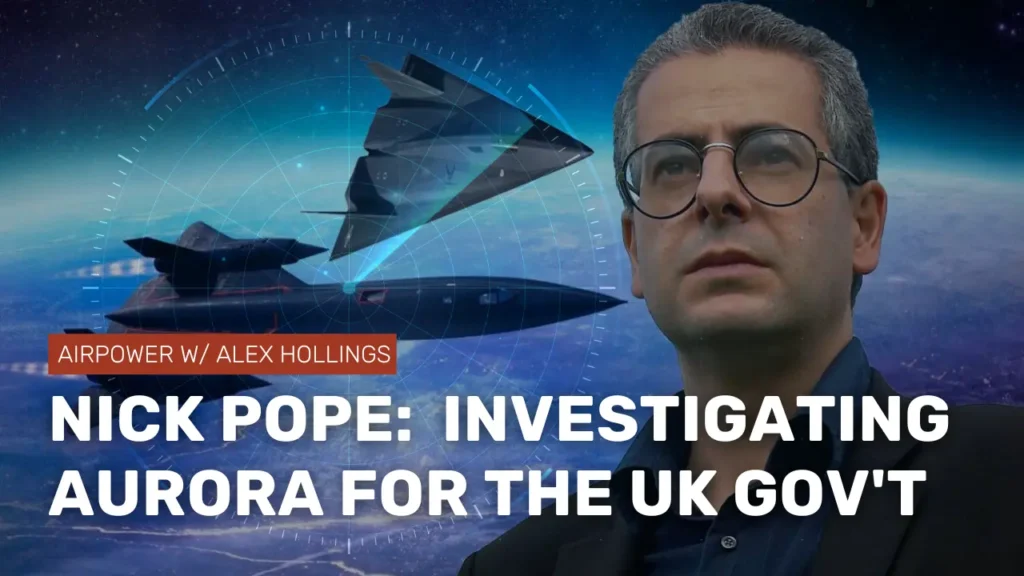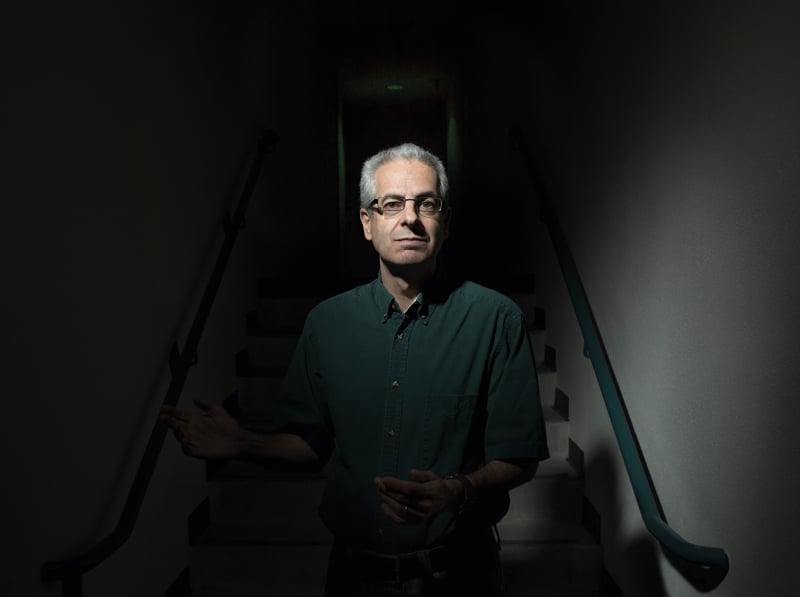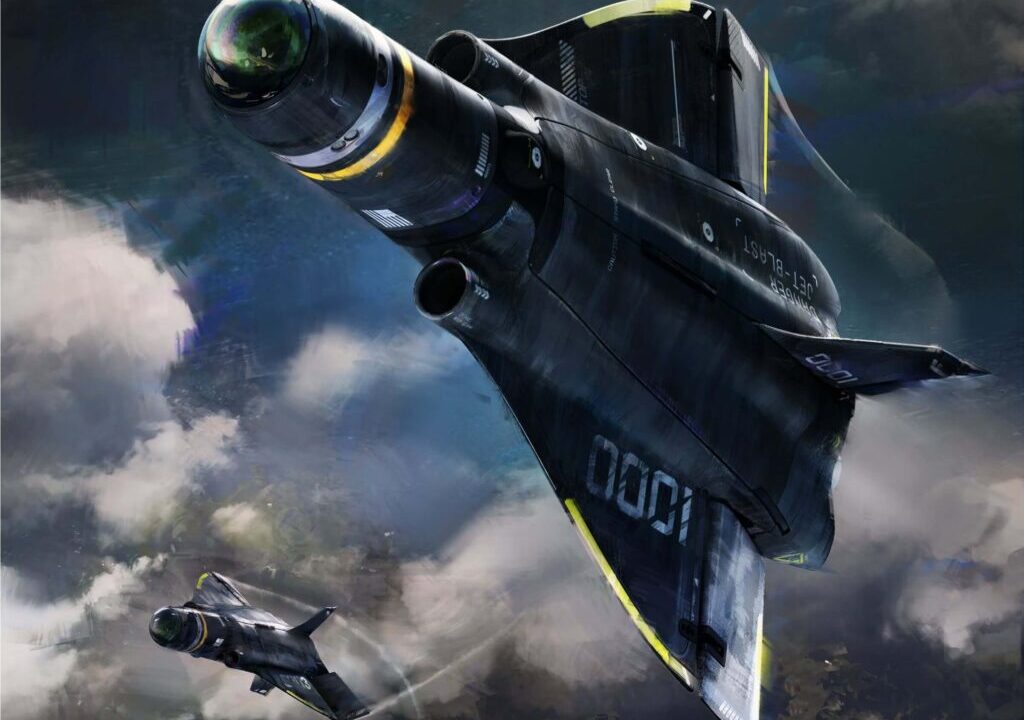Interview with Nick Pope: The man who investigated Aurora for the UK government
- By Alex Hollings
Share This Article

Recently, we published an article and series of videos investigating longstanding reports of a secret hypersonic aircraft known as Aurora, and as luck would have it, we caught the attention of a man named Nick Pope.
You may recognize Pope from his regular television appearances discussing things ranging from classified aircraft programs to unidentified aerial phenomena (UAP) — there’s good reason for that. Between 1985 and 2006, Nick Pope was a civilian employee of the British Ministry of Defence within an organization known as Secretariat (Air Staff). During that time, he was responsible for answering questions about aviation programs, incidents, and controversies for lawmakers within the houses of Parliament.
You can read our original full investigation into Aurora here.

But Pope’s credentials within the disclosed, still-classified, and more mysterious aviation sphere extend still deeper. Between 1991 and 1994, Nick Pope was assigned to Secretariat (Air Staff) 2 — a role more commonly known as simply… the UFO desk.
As a press release from the British National Archives puts it:
“The UFO Desk was staffed by civil servants from the Air Staff Secretariat who received scientific and technical advice from DI55 – a branch of the Defence Intelligence Staff who were responsible for assessing UFO reports for information of intelligence interest.”
We were fortunate enough to sit down with him for a discussion about his days investigating Aurora sightings for the U.K. government.
Related: Was America’s Aurora hypersonic aircraft real? We get to the bottom of it
Nick Pope was tasked with finding answers about Aurora sightings for the UK government
The legends surrounding Aurora began in 1985 when news outlets reported on an unusual line item in a budgetary document outlining potential expenditures for 1987. But the earliest reported sightings attributed to this program actually came from the United Kingdom. The most famous among them came from an oil-rig engineer and trained aircraft observer named Chris Gibson. He reportedly saw an unusual triangular aircraft refueling from a KC-135 while flanked by a pair of American F-111s.
Gibson was soon joined by others who also reported seeing unusual black triangles flying over the U.K., and by the early 1990s, the reports were enough to garner the attention of Parliament. They then turned to the Air Staff Secretariat for answers and before long, the case found its way to the desk of Nick Pope.
“One of the things that I got drawn into was basically answering —when members of parliament and peers, members of the House of Commons or the House of Lords — they can ask formal questions of the Secretary of State for Defense,” Pope told Sandboxx news.
“We received a whole bunch of questions along the lines of: is there an Aurora program? Has the United States government been testing it in the U.K. Air Defence region? Has it, and this was a big allegation, been operating out of RAF Machrihanish, an airbase on the West coast of Scotland?“
Related: Bird of Prey: Boeing’s lost budget-busting stealth fighter
The U.S. Air Force was aggressive in its denials of Aurora

As a part of his investigation, Nick Pope reached out to the American Defense Department through formal channels and intelligence contacts, hoping the U.S. Air Force could shed some light on the mystery. Despite strong ties between the two countries, the line of questioning created some tension.
“We nearly caused — well, we did cause — a diplomatic incident that resulted in a small wrinkle in the so-called ‘special relationship,'” he explained, “Because when we got these questions about Aurora, we, of course, asked our intelligence people to speak to the U.S. intelligence people. We got the embassy involved. There were some meetings and we basically said, ‘look, come on. Is there an Aurora or not?”
Of course, similar questions had already been raised within the United States. Sightings of similar black triangles had been reported in the Southwest alongside credible reports of high-altitude supersonic aircraft being tested in the area. These stories reached aviation industry publications and mainstream news outlets alike. As a result, the secretary of the air force at the time, Donald Rice, had gone on record to Congress denying the existence of the Aurora program.

“Here’s where things got kind of a little spikey. We, in the Ministry of Defence, some of my colleagues didn’t believe it,” Pope recalled.
Internally, the Ministry of Defence acknowledged the American denials of an aircraft like Aurora, but Pope recalls memos circulating about how they wouldn’t be surprised if Aurora (or something like it) turned out to be real anyway. The questions persisted to the point where someone (Pope believes it was an embassy official), asked the U.S. about the program again.
“The quote that came back to us was something to the effect that Donald Rice was ‘incensed, to say the least’ at the implication that he lied to Congress on this,” Pope recalled.
“Because what we were basically saying — or some of us were — that we didn’t believe his denials to Congress. So, it was sort of, ‘Are you sure? Can you have another look? You can tell us, we won’t tell anyone.'”
It wasn’t long before other U.K. government officials stepped in to tell Pope and his colleagues to back off. It wasn’t the only time that Nick Pope had felt as though the American government wasn’t being completely transparent with him. During his tenure at the “UFO desk,” he tried to get in touch with any peers he may have who were studying the same sort of reports within the American Defense apparatus. He was told that the U.S. ended all investigations into such reports with Project Blue Book in 1969, but he had seen intelligence reports that seemed to suggest otherwise.
In 2017, it was revealed that at least one later American effort, known as the Advanced Aerospace Threat Identification Program, operated between 2007 and 2012, and many believe other formal or informal groups looked into unusual reports well before that.
Related: Why is it so hard to develop stealth aircraft?
He dodged the question from Parliament — and was surprised to find they accepted that

The two big questions Nick Pope was tasked with answering for parliament were clear: Was Aurora real? And was it flying in U.K. airspace? Unfortunately, he was ultimately unable to provide a concrete answer to either.
The unsatisfying response Pope ultimately provided can still be found on Hansard, the official report of all parliamentary debates. It reads only:
“The existence of any secret U.S. aircraft known as “Aurora” would be for the United States Government to confirm. No authority has been given for any such aircraft to fly over the United Kingdom or to land in this country and we have no evidence to suggest that such an aircraft has.”
“Uk Airspace: ‘Aurora’ Aircraft,” Volume 560: debated on Monday 30 January 1995, Hansard
Of course, that response really did little more than pass the buck to the United States, who were already publicly denying the aircraft existed. Pope was well aware of that and expected to be rebuked by his superiors or even the British parliament. But the reprimand never came.
“Frankly, I’m the first to admit that was outrageous because that was not the question,” Pope said. “The question was not, does Aurora exist — that was only the first part of it. It was, and is it flying in U.K. airspace?”
“The first part of the question, fair enough, that was a matter for the U.S., but anything flying in our own airspace was absolutely a matter for the U.K. authorities. But I thought, I’ll put it up, I’ll see if we get away with it, we probably won’t… but we did.”
Related: America’s secret stealth aircraft you’ve never heard of
What does Nick Pope think the truth about Aurora really is?

Sharing defense secrets between the U.S. and U.K. governments has been commonplace for decades, from the U.K.’s involvement in the Manhattan Project in the 1940s to Ronald Reagan offering Margaret Thatcher the opportunity to purchase the still-classified F-117 Nighthawk in 1986. But it’s important to remember that the “special relationship” between these governments is still, at a fundamental level, a relationship between two separate nations.
After all, within America’s government itself, Special Access Programs are often withheld from even officials with the highest-reaching security clearances, simply because they don’t need to know.
It was clear to Nick Pope that Uncle Sam wasn’t interested in answering any more questions about Aurora. But does he believe that suggests it was real and just being kept under wraps? Not exactly.
“My best assessment of the whole Aurora controversy is that Aurora, as envisaged by many of the aviation enthusiasts and people in the UFO community probably didn’t exist,” Pope told Sandboxx News.
“In other words, I don’t think there was an operational platform that was ever deployed.”
But Pope’s time within the Ministry of Defence and years studying strange sightings in the sky have left him well aware of the kinds of incredible aircraft that can be fielded by governments like the U.S. in limited numbers.
“What I do think is a sort of halfway-house answer, that there might have been something like Aurora, and something at the prototype stage, but I think that’s about as far as I would go.”
Read more from Sandboxx News
Related Posts
Sandboxx News Merch
-

‘AirPower’ Golf Rope Hat
$31.00 Select options This product has multiple variants. The options may be chosen on the product page -

F-35 ‘Lightning’ Framed Poster
$45.00 – $111.00 Select options This product has multiple variants. The options may be chosen on the product page -

‘Kinetic Diplomacy’ Bumper Sticker (White)
$8.00 Add to cart

Alex Hollings
Alex Hollings is a writer, dad, and Marine veteran.
Related to: Airpower

Game-changing military aircraft that were canceled before they could change the game

Anduril’s Roadrunner is a unique reusable missile interceptor

The AGM-181 LRSO missile will modernize America’s nuclear triad

Navy will soon announce the contract award for its F/A-XX 6th-generation jet, according to reports
Sandboxx News
-

‘Sandboxx News’ Trucker Cap
$27.00 Select options This product has multiple variants. The options may be chosen on the product page -

‘AirPower’ Classic Hoodie
$46.00 – $48.00 Select options This product has multiple variants. The options may be chosen on the product page -

‘AirPower’ Golf Rope Hat
$31.00 Select options This product has multiple variants. The options may be chosen on the product page -

‘Sandboxx News’ Dad Hat
$27.00 Select options This product has multiple variants. The options may be chosen on the product page
